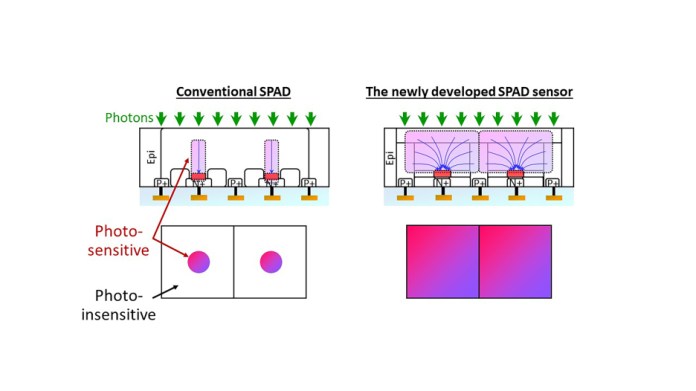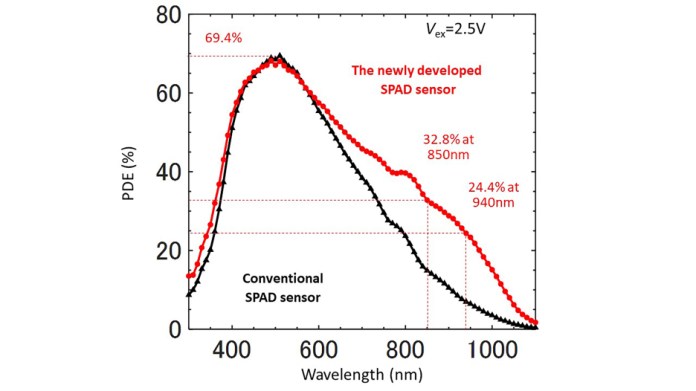Canon Inc. has developed an ultra-small single photon avalanche diode (SPAD) image sensor, measuring 13.2 × 9.9 mm, claiming the highest resolution of 3.2-megapixel (MP) images — a higher resolution than full HD (approximately 2.07 MP) – even in low-light or dark environments.
Canon unveiled the first 1-MP SPAD image sensor in June 2020. Thanks to the SPAD sensor’s unique design and proprietary pixel architecture noise doesn’t interfere with the readout of light as electrical signals, which enables clear image capture without signal noise. This translates into advantages of greater sensitivity during image capture and high-precision distance measurement, said Canon.
Under equivalent light, the SPAD sensor is said to capture the same images as a conventional CMOS sensor with 1/10 of the imaging area due to the pixel architecture.

Figure 2: Cross-sectional views and top-view layouts of a conventional BSI SPAD array (left) and BSI charge focusing SPAD array (right). Thanks to a proprietary voltage accumulation architecture that increases photon collection efficiency, the sensor achieves high performance in three different metrics: (1) near-infrared light spectrum sensitivity, (2) low noise and (3) high detection speed (temporal resolution). Click for a larger image. (Source: Canon Inc.)
This enables an ultra-small design and greatly increases sensitivity, including for light on the near-infrared spectrum. It also allows video capture with 3.2 MP under low-light conditions of 0.002 lux1, which is darker than a starless night sky, said Canon. As a result, video footage in low-light environments can be captured as if it were recorded in bright areas (See Figure 3a, b, and c).

Figure 3b: Low-light condition at 0.002 lux using a SPAD sensor. Click for a larger image. (Canon Inc.)

Figure 3c: Low-light condition at 0.0003 lux, which is equivalent to conditions in which the naked eye cannot perceive objects, using a SPAD sensor. Click for a larger image. (Canon Inc.)
The new SPAD sensor achieves a high photon detection efficiency (PDE) of 24.4% for 940-nm wavelength light on the near-infrared spectrum and is said to deliver high data processing speeds at 100 picoseconds, which enables it to capture objects moving at high speeds.

Figure 4: Measured PDE comparison between previous Canon-developed SPAD sensors and the newly developed SPAD sensors. (Source: Canon Inc.)
Thanks to its high resolution and high sensitivity coupled with the fast response the SPAD sensor can be used in a range of applications including self-driving vehicles, medical treatment, diagnostic imaging devices, and scientific precision measuring instruments, said Canon.
Volume manufacturing is expected to start in the second half of 2022.
1 Light from stars is estimated at 0.02 lux. Ambient light in starless night environment is estimated at 0.007 lux.
Advertisement
Learn more about Canon U.S.A.







